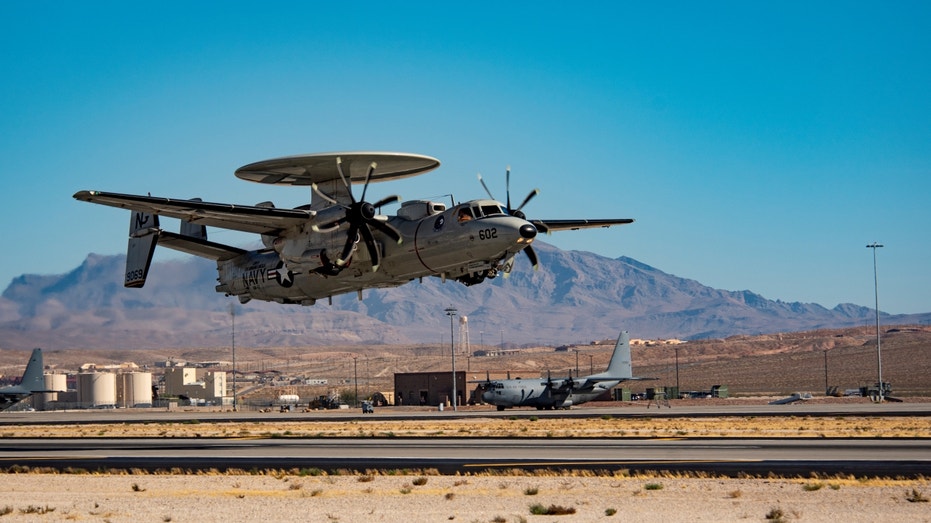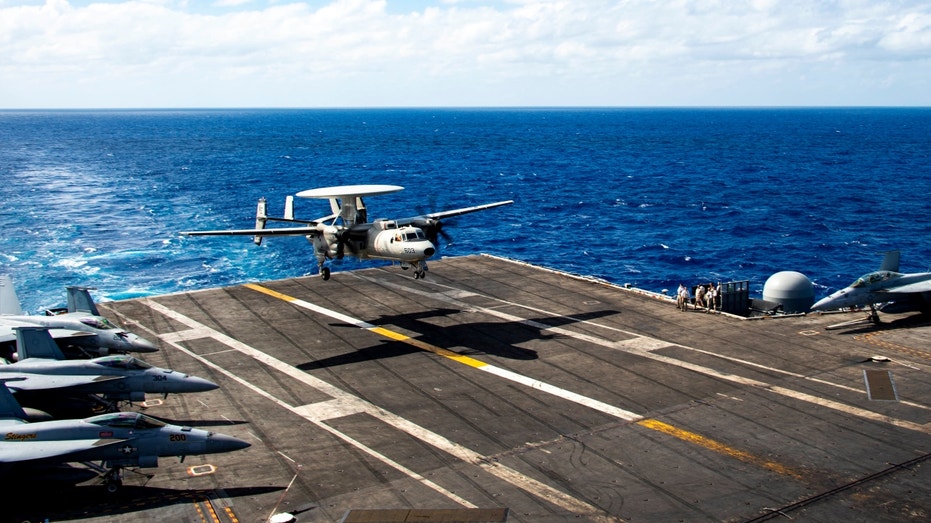US approves $1.3 billion deal for Japan to buy early warning aircraft amid China threat
The Advanced Hawkeye's radar system is reportedly capable of tracking stealth aircraft
Japan 'more likely' to be a victim by Chinese aggression: Gordon Chang
Author of "The Coming Collapse of China" Gordon Chang discusses the meeting with President Biden and the Japanese Prime Minister amid tensions with China, and China's management of COVID amid rising cases.
The U.S. granted approval for the government of Japan to purchase airborne early warning aircraft in a deal valued at more than $1.3 billion as the country seeks to bolster its defense capabilities amid the growing threat from China.
In an announcement Tuesday, the State Dept. approved Japan’s request to buy up to five E-2D Advanced Hawkeye (AHE) Airborne Early Warning and Control (AEW&C) Aircraft, which is made by Northrop Grumman. The deal, which carries an estimated cost of $1.381 billion, also includes radars, engines, radios, advanced electronic systems, and spare parts. Congress can technically vote to block the sale, although it’s unlikely to do so given the deep ties and mutual defense treaty alliance between the U.S. and Japan.
The Hawkeye features a prominent rotating radar dome that is mounted atop its fuselage and wings that contains advanced electronic sensors used to detect incoming aircraft, missiles, and ships at long ranges that could pose a threat to friendly forces. It also serves in a command and control role by helping to direct and track the movements of friendly and enemy forces and coordinating engagements by friendly aircraft, ships, and land-based forces.
JAPAN PLANS TO BUY 400 TOMAHAWK MISSILES FROM US TO DETER THREATS FROM CHINA, NORTH KOREA

A U.S Navy E-2D Advanced Hawkeye aircraft takes-off during a U.S. Air Force Weapons School (USAFWS) Integration exercise at Nellis Air Force Base, Nevada, Nov. 19, 2020. Japan is planning to acquire additional Advanced Hawkeye aircraft from the U.S.
The Advanced Hawkeye’s APY-9 radars — which would be included in the deal — are reportedly capable of tracking stealth aircraft that ordinarily have a very small radar cross-section when viewed by more common, less sophisticated radar systems. That capability would be crucial in a conflict with China, which fields a significant number of fifth-generation fighters, and with Russia, which has fewer aircraft with stealth capabilities in its arsenal.
Hawkeyes are carrier-capable aircraft featuring a tailhook for arrested landings and have been widely used by the U.S. Navy’s carrier air wings for decades in their airborne early warning capacity. However, the Japan Maritime Self-Defense Force’s light carriers can only support helicopters and short-takeoff and vertical landing aircraft like the F-35B Lightning, so the country’s Hawkeyes are land-based and operate under the Japan Air Self-Defense Force.
LOCKHEED MARTIN AWARDED NAVY HYPERSONIC MISSILE CONTRACT WORTH OVER $1 BILLION

PHILIPPINE SEA (Jan. 29, 2022) An E-2D Advanced Hawkeye, assigned to the "Black Eagles" of Carrier Airborne Early Warning Squadron (VAW) 113, recovers on the flight deck of Nimitz-class aircraft carrier USS Carl Vinson (CVN 70), Jan. 29, 2022. (U.S. Navy photo by Mass Communication Specialist 3rd Class Jeff D. Kempton / DVIDS)
Japan’s interest in Hawkeye’s airborne early warning capability emerged after a 1976 incident in which a Soviet pilot flew into Japan’s airspace to land and defect, exposing vulnerabilities in its air defense system in the process. Japan’s ground-based radar systems and aircraft that were scrambled lost track of the Soviet aircraft — which nearly hit an airliner that was taking off when it landed at a civilian airport.
Japan has operated the earlier E-2C Hawkeye variant since 1984 and acquired its first upgraded E-2D Advanced Hawkeye in 2019. The Defense Security Cooperation Agency (DSCA) noted in its announcement of the latest sale’s approval that, "Japan will have no difficulty absorbing this equipment into its armed forces."

An E-2D Advanced Hawkeye is offloaded at Marine Corps Air Station Iwakuni, Japan, Oct. 18, 2022. The aircraft was unloaded from the vehicle carrier ship Ocean Gladiator to be delivered to the Japan Air Self-Defense Force. (U.S. Marine Corps Photo by Lance Cpl. David Getz / DVIDS)
GET FOX BUSINESS ON THE GO BY CLICKING HERE
DSCA added, "This proposed sale will support the foreign policy goals and national security objectives of the United States by improving the security of a major ally that is a force for political stability and economic progress in the Asia-Pacific region."
Other countries that currently operate variants of the Hawkeye include Egypt, France, Mexico, and Taiwan.
| Ticker | Security | Last | Change | Change % |
|---|---|---|---|---|
| NOC | NORTHROP GRUMMAN CORP. | 568.33 | +8.97 | +1.60% |




















